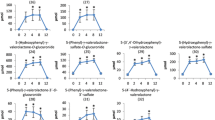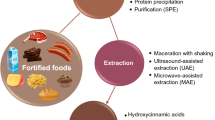Abstract
The objective of the study was to determine the effects of green tea, black tea and decaffeinated black tea consumption on urinary and fecal excretions and whole blood and blood serum concentrations of polyphenols. The 56 day study was divided into four randomly arranged experimental periods of 14 days each during which the 10 healthy adult subjects consumed a laboratory controlled, constant, measured diet based on ordinary foods. During separate periods, subjects received no tea, green tea, regular black tea or decaffeinated black tea beverages at the three daily meals. Subjects made complete collections of urine and stools throughout the study and fasting blood samples were drawn at the beginning of the study and at the end of each experimental period. Polyphenols contained in urine, feces, whole blood, blood serums, food and tea were analyzed by the spectrophotometry method of Wah Lau et al. (1989). Green tea consumption resulted in highest intakes in greatest fecal and urinary excretions, highest retentions, and high whole blood concentrations of polyphenols followed by effects of regular black tea, decaffeinated black tea and no tea treatments. These results indicate that polyphenols from tea are at least partly absorbable. Hence, both positive and negative effects of dietary polyphenol may occur internal to the body proper and not only as effects within the intestines.
Similar content being viewed by others
References
Stagg BV, Millin DJ (1991) The nutritional and therapeutic value of tea. J Sci Food Agric 26: 1439.
Eggum BO, Christensen KD (1975) In: Breeding for seed protein improvement using nuclear techniques. Proc Res Co-ord Meeting Ibadan, 1973. Vienna: International Atomic Energy Authority 1975; 135.
Asquith TN, Butler LG (1986) Interactions of condensed tannin with selected proteins. Phytochemistry 25: 1591.
Wang RS, Kies C (1991) Niacin, thiamin, iron and protein status of humans as affected by the consumption of tea (Camellia sinensis) infusions. Plant Foods Hum Nutr 41: 337–353.
Price ML, Butler LG (1980) Tannin and nutrition. Purdue Univ. Agric Exp Stn Bull 272.
Disler PB, Sayers SR, Lynch RW, Charlton TH (1975) The effect of tea on iron absorption gut. Phytochemistry 16: 193.
Hallerg L, Rossander L (1982) Effect of different drinks on the absorption of non-heme iron from composite meals. Human Nutr Appl Nutr 36: 116 (abstract).
Razagui IB, Barlow PJ, Izmeth MG, Taylor KD (1991) Iron status in a group of long-stay mentally handicapped menstruating women: Some dietary considerations. Eur J Clin Nutr 45: 331–40.
Rosenberg IH (1991) The influence of tea on iron and aluminum bioavailability in the rat. Nutr Rev 49: 287–9.
Ruenwongsa P, Pattanavibag S (1983) Decrease in the activities of thiamin pyrophosphate dependent enzymes in rat brain after prolonged tea consumption. Nutr Rep Inter 27: 713.
Vimokesant SL, Nadornchai S, Dhanamitta, DM (1974) Effect of tea consumption on thiamin status in man. Nutr Rep Inter 9: 371.
Haslam E, Lilley T (1988) Natural astringency in foodstuffs: A molecular interpretation. Crit Rev Food Sci Nutr 27: 1–40.
Young W, Hotovec RL, Romero AG (1976) Tea and atherosclerosis. Nature 216: 1015–1016.
Suminori K, Koichi S, Nariaki I (1992) Green tea consumption and serum lipid profiles: A cross-sectional study in Northern Kyushu, Japan. Prev Med 21: 526–531.
Muramatsu K, Fuduyo M, Hara U (1986) Effect of green tea catechins on plasma cholesterol level in cholesterol-fed rats. J Nutr Sci Vitaminol 32: 613–622.
Sheriff DS, Fakhri MEL (1988) Tea consumption and serum lipids in a Libyan population in Benghazi. Ann Clin Biochem 25: 670–672.
Wang -ZY, Huang -MT, Ferraro -T, Wong -CQ, Lou -YR (1992) Inhibitory effect of green tea in the drinking water on tumorigenesis by ultraviolet light and 12-O-tetradecanoylphorbol-13-acetate in the skin of SKH-1 mice. Cancer Res 52(5): 1162–70.
Yoshizawa S, Horiuchi T, Fujiki H, Uoshida T, Okuda T, Sugimura T (1987) Antitumor promoting activity of (-)-epigallocatechin gallate, the main constituent of ‘tannin’ in green tea. Phytother Res 1: 44–47.
Li -Y (1991) Comparative study on the inhibitory effect of green tea, coffee and levamisole on the hepatocarcinogenic action of diethylnitrosamine. Chung-Hua-Chung-Liu-Tsa-Chih 13(3): 193–5.
Chung FL, Xu -Y, Ho -CT (1992) Inhibition of tobacco-specific nitrosamine-induced lung tumorigenesis in A/J mice by green tea and its major polyphenol as antioxidants. Cancer Res 52(14): 3875–9.
Junshi Chen (1992) The effects of Chinese tea on the occurrence of esophageal tumors induced by N-nitrosomethylbenzylamine in rats. Prev Med 21: 358–391.
Zhen Y, Cao S, Xue Y, Wu S (1991) Green tea extract inhibits nucleoside transport and potentiates the antitumor effect of antimetabolite. Chin Med Sci J 6: 1–5.
Wah Lau, Shiu Fai Luk, Hsiao-Ian Huang (1989) Spectrophotometric determination of tannins in tea and beer samples with iron (III) and 1,10-phenanthroline as reagents. Analyst 11: 765–768.
Singleton VL, Kratzer FH (1973) Plant phenolics: Toxicant occurring naturally in foods. Natl Acad Sci (Washington, DC) 2: 309–345.
Singleton VL (1981) Naturally occurring food toxicant: Phenolic substances of plant origin common in foods. Advances in Food Research 27: 149–242.
Williams RT (1959) Detoxication mechanism, the metabolism and detoxication of drugs, toxic substances and other organic compound: Toxic substances and other organic compounds. London: Chapman & Hall, pp. 806–864.
Griffiths LA, Barrow A (1972) Metabolism of flavonoid compounds in germ-free rats. Biochem J 130: 1161–1162.
Griffiths LA, Hackett AM (1977) The biliary excretion of flavonoids. Flavonoids Bioflavonoids. Proc Hung Bioflavonoid Symp 5: 325–332.
Hackett AM, Marsh BA, Griffiths LA (1979) The biliary excretion of flavanones in the rat. Xenobiotica 9: 491–502.
Geoffrey VS, David JM (1975) The nutritional and therapeutic value of tea: A Review. J Sci of Food and Agric 26: 1439–1460.
Farkas L, Gabor M (1973) Topics in flavonoid chemistry and biochemistry. Proc Hung Bioflavonoid Symp 4: 286–298.
Kuhnau J (1976) The flavonoids: A class of semi-essential food components: their role in human nutrition. World Rev Nutr 24: 117–191.
Takacs O, Gabor M (1973) New data on the metabolism of flavonoids. Proc Hung Bioflavonoid Symp 4: 227–231.
Forster H (1977) Absorption and metabolism of flavonoids in man. Flavonoids Bioflavonoids Proc Hung Bioflavonoid Symp 5: 333–346.
Laparra J, Michaud J, Masquelier J (1977) Etude pharmacocinetique des oligomeres flavonoliques. Plant Med Phytother 11: 133–142.
Krantz JC (1955) In: Tea: A Symposium on the Pharmacological and the Physiological and Psychological Effects of Tea. Washington, DC: Biological Sciences Foundation.
Author information
Authors and Affiliations
Rights and permissions
About this article
Cite this article
He, Y.H., Kies, C. Green and black tea consumption by humans: Impact on polyphenol concentrations in feces, blood and urine. Plant Food Hum Nutr 46, 221–229 (1994). https://doi.org/10.1007/BF01088994
Received:
Accepted:
Issue Date:
DOI: https://doi.org/10.1007/BF01088994




